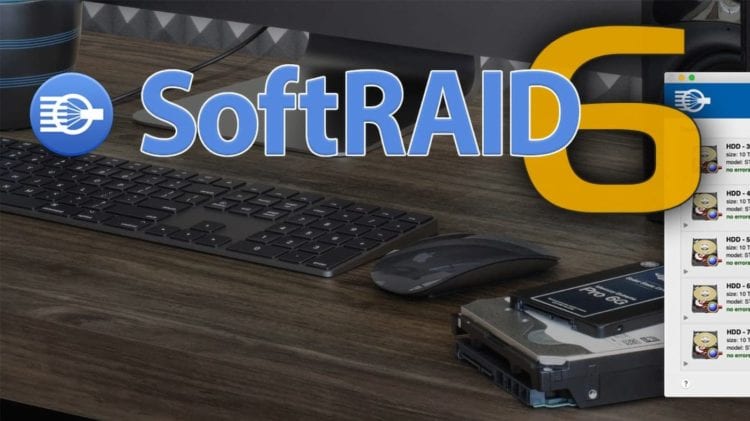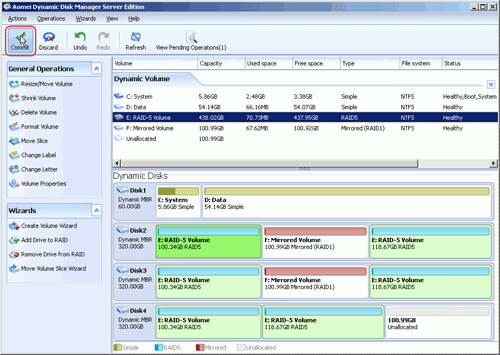

- Softraid convert disk to raid 5 how to#
- Softraid convert disk to raid 5 series#
- Softraid convert disk to raid 5 mac#
Validating a volume ensures that all sectors are readable. The last time the volume was validated.The choices are: Workstation, Server, Digital Video, Digital Audio or Digital Photography
Softraid convert disk to raid 5 how to#
This tells SoftRAID how to prioritize rebuild and validate operations relative to file reads and writes. It also prevents a volume’s disks from accidentally being initialized or overwritten. A safeguard prevents a volume from being accidentally erased or deleted. There’s a lot of important information shown on your volume tile: You can click on a volume tile to see which disks it uses.

They also show you whether a volume is degraded, i.e no longer protected from a failing disk. Volume tiles show you the size and RAID level of each volume. A RAID volume uses parts of two or more disks to store your files.
Softraid convert disk to raid 5 mac#
SoftRAID displays a tile for all volumes which your Mac can access without using a network. You can click on the disclosure triangle to see more information about a volume and whether it has encountered any errors. *SMART is a monitoring system in disk drives that SoftRAID Monitor uses to assess drive reliability and anticipate drive failures.Ī volume tile shows you information about a volume.

The progress and time remaining for any disk operation – like certifying or verifying a disk.The number of hours a disk has been used.The disk above has been labeled: “Offsite Backup #1.” The SoftRAID Monitor uses a disk’s label when reporting errors in dialog boxes, log files or via email. The label is a name you can add to make it easier to keep track of a particular disk. Any label you have added to this disk.SoftRAID uses internal counters in each disk to determine if a disk is more likely to fail. The SMART* status of a disk – this is checked each time you run the SoftRAID application, every time you startup your Mac and every 24 hours while your Mac is running.There’s a lot of information shown on your disk tile: You can also click on a disk tile to see which volumes use that disk. SoftRAID displays a separate tile for each disk connected to your Mac.Īll SSDs and external disk drives connected via Thunderbolt, SATA, FireWire, Fibre or USBĬonnected USB flash drives (aka thumb drive) – yes, SoftRAID even works with those!ĭisk tiles show you whether a disk is working correctly or needs to be replaced. You can click on the disclosure triangle to see more information about a disk and whether you need to replace it. Select either one or two disks, depending on your preference, to be added to the array and proceed to the next screen.A disk tile shows you the size and type of a disk attached to your Mac.NOTE: while it is available to expand the RAID1 array, this would merely create another mirror of the drive, using all the added space to secure the array from the failure of the second drive. Confirm Change RAID type as requested task.After the conversion is done, the screen should look like this.ģ) Converting RAID volumes to a higher level RAID volume.You can monitor the status of the operation in the storage manager.Verify the operation parameters and confirm it.Select disk to be added to the array and proceed to the next screen.Select the desired volume in the list and click on Manage.If you intend to expand your JBOD array, please back up all your data and re-create the array with the desired number of drives. Please note that JBODs cannot be expanded without formatting due to the technique of data recording (stripping) - while technically possible, this operation would be highly dangerous as any interruption to the task would destroy all of your data. Similarly, a basic disk can be converted to RAID5 by first creating a RAID1 array. RAID1 volume can be expanded to RAID6 indirectly within two steps if desired. RAID5 (stripping + single parity) to RAID6 (stripping + dual parity).RAID1 (mirror) to RAID5 (stripping + single parity).For this reason, only limited operations are possible without the need to format the drives: While the idea between RAID arrays is always the same, the techniques of storing the data can be very different. Converting RAID volumes to a higher level RAID volume.This article describes valid conversion targets and guides you through the process.
Softraid convert disk to raid 5 series#
Our NAS series appliances offer quick and easy transitions between volume types without the need of formatting the drives.


 0 kommentar(er)
0 kommentar(er)
